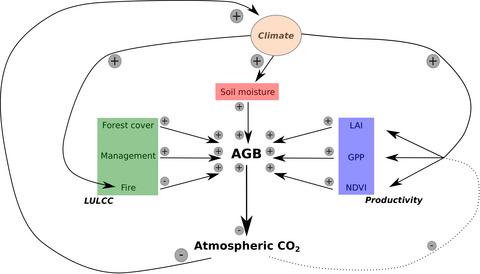当前位置:
X-MOL 学术
›
Glob. Change Biol.
›
论文详情
Our official English website, www.x-mol.net, welcomes your
feedback! (Note: you will need to create a separate account there.)
Global sensitivities of forest carbon changes to environmental conditions
Global Change Biology ( IF 10.8 ) Pub Date : 2021-09-09 , DOI: 10.1111/gcb.15877 Simon Besnard 1, 2 , Maurizio Santoro 3 , Oliver Cartus 3 , Naixin Fan 1 , Nora Linscheid 1 , Richard Nair 1 , Ulrich Weber 1 , Sujan Koirala 1 , Nuno Carvalhais 1, 4
Global Change Biology ( IF 10.8 ) Pub Date : 2021-09-09 , DOI: 10.1111/gcb.15877 Simon Besnard 1, 2 , Maurizio Santoro 3 , Oliver Cartus 3 , Naixin Fan 1 , Nora Linscheid 1 , Richard Nair 1 , Ulrich Weber 1 , Sujan Koirala 1 , Nuno Carvalhais 1, 4
Affiliation

|
The responses of forest carbon dynamics to fluctuations in environmental conditions at a global scale remain elusive. Despite the understanding that favourable environmental conditions promote forest growth, these responses have been challenging to observe across different ecosystems and climate gradients. Based on a global annual time series of aboveground biomass (AGB) estimated from radar satellites between 1992 and 2018, we present forest carbon changes and provide insights on their sensitivities to environmental conditions across scales. Our findings indicate differences in forest carbon changes across AGB classes, with regions with carbon stocks of 50–125 MgC ha−1 depict the highest forest carbon gains and losses, while regions with 125–150 MgC ha−1 have the lowest forest carbon gains and losses in absolute terms. Net forest carbon change estimates show that the arc-of-deforestation and the Congo Basin were the main hotspots of forest carbon loss, while a substantial part of European forest gained carbon during the last three decades. Furthermore, we observe that changes in forest carbon stocks were systematically positively correlated with changes in forest cover fraction. At the same time, it was not necessarily the case with other environmental variables, such as air temperature and water availability at the bivariate level. We also used a model attribution method to demonstrate that atmospheric conditions were the dominant control of forest carbon changes (56% of the total study area) followed by water-related (29% of the total study area) and vegetation (15% of the total study area) conditions. Regionally, we find evidence that carbon gains from long-term forest growth covary with long-term carbon sinks inferred from atmospheric inversions. Our results describe the contributions from the atmosphere, water-related and vegetation conditions to forest carbon changes and provide new insights into the underlying mechanisms of the coupling between forest growth and the global carbon cycle.
中文翻译:

森林碳变化对环境条件的全球敏感性
森林碳动态对全球范围内环境条件波动的响应仍然难以捉摸。尽管人们认为有利的环境条件会促进森林生长,但在不同的生态系统和气候梯度中观察这些反应仍然具有挑战性。基于 1992 年至 2018 年间雷达卫星估计的全球地上生物量 (AGB) 年度时间序列,我们展示了森林碳变化,并提供了有关它们对跨尺度环境条件敏感性的见解。我们的研究结果表明不同 AGB 类别的森林碳变化存在差异,碳储量为 50-125 MgC ha -1 的区域描述了最高的森林碳收益和损失,而具有 125-150 MgC ha -1 的区域 从绝对值来看,森林碳的收益和损失最低。净森林碳变化估计表明,森林砍伐弧和刚果盆地是森林碳损失的主要热点,而在过去三十年中,欧洲森林的很大一部分获得了碳。此外,我们观察到森林碳储量的变化与森林覆盖率的变化系统地正相关。同时,其他环境变量的情况不一定如此,例如双变量水平的气温和可用水量。我们还使用模型归因方法来证明大气条件是森林碳变化的主要控制因素(占总研究面积的 56%),其次是与水相关(占总研究面积的 29%)和植被(占总研究面积的 15%)。总研究面积)条件。在区域上,我们发现证据表明长期森林生长的碳收益与从大气逆温推断的长期碳汇共变。我们的研究结果描述了大气、水相关和植被条件对森林碳变化的贡献,并为森林生长与全球碳循环之间耦合的潜在机制提供了新的见解。
更新日期:2021-11-12
中文翻译:

森林碳变化对环境条件的全球敏感性
森林碳动态对全球范围内环境条件波动的响应仍然难以捉摸。尽管人们认为有利的环境条件会促进森林生长,但在不同的生态系统和气候梯度中观察这些反应仍然具有挑战性。基于 1992 年至 2018 年间雷达卫星估计的全球地上生物量 (AGB) 年度时间序列,我们展示了森林碳变化,并提供了有关它们对跨尺度环境条件敏感性的见解。我们的研究结果表明不同 AGB 类别的森林碳变化存在差异,碳储量为 50-125 MgC ha -1 的区域描述了最高的森林碳收益和损失,而具有 125-150 MgC ha -1 的区域 从绝对值来看,森林碳的收益和损失最低。净森林碳变化估计表明,森林砍伐弧和刚果盆地是森林碳损失的主要热点,而在过去三十年中,欧洲森林的很大一部分获得了碳。此外,我们观察到森林碳储量的变化与森林覆盖率的变化系统地正相关。同时,其他环境变量的情况不一定如此,例如双变量水平的气温和可用水量。我们还使用模型归因方法来证明大气条件是森林碳变化的主要控制因素(占总研究面积的 56%),其次是与水相关(占总研究面积的 29%)和植被(占总研究面积的 15%)。总研究面积)条件。在区域上,我们发现证据表明长期森林生长的碳收益与从大气逆温推断的长期碳汇共变。我们的研究结果描述了大气、水相关和植被条件对森林碳变化的贡献,并为森林生长与全球碳循环之间耦合的潜在机制提供了新的见解。











































 京公网安备 11010802027423号
京公网安备 11010802027423号